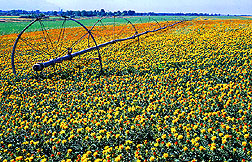Deep-Rooted Safflower Cuts Fertilizer Losses
A field of safflower in full bloom casts a beautiful yellow glow across the western Great Plains. But to farmers, safflowers' best features are underground.
An oilseed, safflower could be a high-value rotation crop—a crop planted every 2 to 4 years—for wheat farmers using no-till or conservation tillage, say Agricultural Research Service soil scientists Donald Tanaka and Steve Merrill. They work in the Natural Resources Management Research Unit at Mandan, North Dakota.
No-till farming systems use no tillage, or very reduced amounts, to preserve the natural organic content of the soil. Wheat growers rely on crop rotation to disrupt the life cycles of insect pests, weeds, and diseases.
Tanaka says safflower may be a good alternative because its deep roots take up water and nutrients that are out of reach of other crops.
Safflower has been cultivated on other continents for centuries, but it has been planted in the United States only since the 1950s. Its seeds can be processed for cooking oil or sold for high-quality bird food.
Tanaka says farmers began planting more safflower in the western plains in the early 1980s, but it didn't do well in heavily tilled fields. The switch to conservation tillage in recent years has encouraged production.
"Safflower is best suited to dry, temperate climates such as those in North Dakota, Nebraska, eastern Montana, and other areas of the western Great Plains," Tanaka says.
"It does better in no-till or minimum-till systems because the seeds can be planted closer to the soil surface. Also, the higher moisture content of no-till fields favors germination and stand establishment. Safflower is particularly suited to our area of the country."
Research conducted by Merrill shows that safflower roots descend up to 7 feet and can tap water and nutrients deep underground, in subsoil. "Wheat and other cereal grains, like oats, can typically reach about 4 feet down into the soil profile," he says.
And another plus: "Safflower's deeper roots can reach fertilizer that may have leached below the root zone of other crops," says Merrill.
ARS research shows up to 50 percent less nitrate in the soil in years when safflower was planted in rotation with wheat. Nitrate is another form of nitrogen, an important nutrient to crops.
"By using safflower in a crop rotation, you prevent movement of nitrate into the groundwater because the nitrogen is being used to produce seeds," says Tanaka. "And when the plant removes water from the subsoil, lost nutrients are used by the plant and don't move toward the groundwater."
Safflower also encourages carbon sequestration, a process in which plants remove carbon dioxide from the atmosphere. More research is needed to learn how much carbon is absorbed and transferred to the soil.—By Dawn Lyons-Johnson, Agricultural Research Service Information Staff, 1815 North University Street, Peoria, IL 61604, phone (309) 681-6534.
Donald L. Tanaka and Stephen D. Merrill are in the USDA-ARS Natural Resources Management Research Unit, Northern Great Plains Research Laboratory, P.O. Box 459, Mandan, ND 58554; phone (701) 663-6445, fax (701) 667-3054.
"Deep-Rooted Safflower Cuts Fertilizer Losses" was published in the April 1998 issue of Agricultural Research magazine. Click here to see this issue's table of contents.







